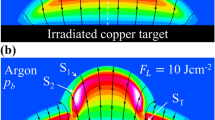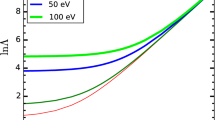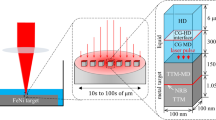Abstract
Particles are sometimes emitted during the ablation of the metal targets used for laser pumped coherent and incoherent light sources. These particles have a significant effect on the absorption efficiency of the laser, on the density and temperature distribution of the plasmas, and thus on the performance of the source. We propose a simulation model of the particle emission based on Lagrangian hydrodynamics taking the liquid-to-gas transition into account using a dynamic mesh reorganization technique.
Access provided by CONRICYT-eBooks. Download conference paper PDF
Similar content being viewed by others
1 Introduction
Laser-pumped plasma (LPP) extreme ultraviolet (EUV) light sources have been thoroughly investigated, and recently an output power of more than 100 W with 5% convergence efficiency (CE) has been achieved using the double-pulse technique [1], as shown in Fig. 55.1. First, the Sn droplet target is irradiated by a short pre-pulse laser with a temporal duration of \(\approx \)10 ps, and is broken up into small particles. Second, when the cloud of particles has expanded to a radius 10 times larger than that of the original droplet, the target is irradiated by the main CO\(_2\) to produce a plasma with appropriate density and temperature for EUV emission [2]. We present a model of the particle emission to optimize the absorption efficiency of the laser, and thus the CE.
2 Model
We developed a model of the ablation of the laser-heated Sn target. The EUV emission is obtained from the heated plasma with an electron temperature \(T_e\approx \) 50 eV, in which Sn atoms are ionized to multiple charged states. By the irradiation of the relatively weak pre-pulse laser, initially, solid Sn target melts and evaporate at a temperature below the critical temperature, producing particles during the liquid-to-gas transition.
The present model is based on the two dimensional (2D) Lagrangian hydrodynamics on triangular grids. We take into account the properties of the target material near the solid-density and warm-temperature regions, \(T_e\le 1\) eV, on the basis of the Van der Waals equation of state,
where P, T, and \(V_m\) are the pressure, temperature, and specific volume per mole, respectively, and a and b are the Van del Waals constant for Sn [3]. The equations of the hydrodynamics are,
where \(\rho \), \(\varvec{u}\), are the density and velocity the fluid, and \(U_m\), \(Q_m\) are the specific internal energy and heating, respectively.
The Van der Waals equation of state is the simplest model that represents the liquid-to-gas transition. The model gives a two-phase region in the density and temperature plane, where the material splits into separate liquid and gas components with a void ratio of \(\alpha \). In the present model, if the density and temperature of a Lagrangian cell are found to be inside the two-phase region, the cell is split into several cells to have the correct void ratio for the group of the cells.
We developed algorithms for mesh reorganization, as shown in Fig. 55.2. We used the time splitting method, in which calculation of the hydrodynamics motion and reorganization of the mesh are carried out alternately in each time step. To reduce the distortion of the mesh, we calculate the aspect ratio of each cell, and if it exceeds a certain limit, we apply one of reconnection, split, division, and union algorithms illustrated in Fig. 55.2, conserving the volume, mass, and energies of the target cells, and we place grids along the distribution of material and particles in the gas phase and bubbles in the liquid phase. As an application of these algorithms, the liquid-to-gas transition is represented by splitting a target cell into liquid and gas cells.
3 Result and Discussion
First, we validated the code through a comparison with a simple 1D model for the adiabatic expansion of low-density gas to obtain reasonable agreement. Second, we carried out a calculation of a heated liquid Sn cylinder. As shown in Fig. 55.3, the target is initially heated at the liquid density; then, small bubbles appear, which expand until finally the target decomposes into particles. We appreciate that the material is at rest until the gas phase becomes dominant. In future work, the present model will be applied to investigate the laser–matter interaction in the plasmas for the EUV source.
References
Mizoguchi, H., et al.: In: Proceedings of SPIE 9776 Extreme Ultraviolet (EUV) Lithography VII, 97760J (2016)
Sasaki, A., et al.: Modeling of radiative properties of Sn plasmas for extreme-ultraviolet source. J. Appl. 107, 113303 (2010)
Young, D.A.: Critical point of metals from the van der Waals model. Phys. Rev. A 3, 364 (1971)
Acknowledgements
This work was supported by JSPS grant No. 26610195.
Author information
Authors and Affiliations
Corresponding author
Editor information
Editors and Affiliations
Rights and permissions
Copyright information
© 2018 Springer International Publishing AG
About this paper
Cite this paper
Sasaki, A., Sunahara, A., Nishihara, K., Nishikawa, T. (2018). Modeling of Ablation of the Target Material for the Plasma for Coherent and Incoherent EUV Sources. In: Kawachi, T., Bulanov, S., Daido, H., Kato, Y. (eds) X-Ray Lasers 2016. ICXRL 2016. Springer Proceedings in Physics, vol 202. Springer, Cham. https://doi.org/10.1007/978-3-319-73025-7_55
Download citation
DOI: https://doi.org/10.1007/978-3-319-73025-7_55
Published:
Publisher Name: Springer, Cham
Print ISBN: 978-3-319-73024-0
Online ISBN: 978-3-319-73025-7
eBook Packages: Physics and AstronomyPhysics and Astronomy (R0)







